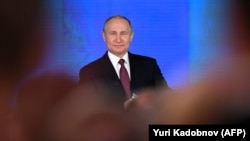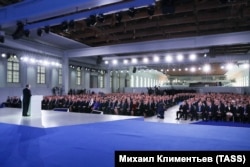WASHINGTON -- If it hasn’t started already, then a new arms race is almost certainly about to get under way, arms-control experts and analysts warn.
With his announcement that Russia has developed new strategic weapons, including a nuclear-powered missile that he said can fly indefinitely and evade U.S. missile defenses, President Vladimir Putin grabbed the attention of policymakers, military experts, and legislators from Washington to Berlin.
He made clear that was the intention and laid the blame on a 16-year-old grievance over a collapsed arms control treaty with the United States.
“Nobody listened to us then,” Putin said in his March 1 live televised speech before hundreds of lawmakers and other officials. “Well, listen up now.”
Moscow and Washington, which combined hold some 93 percent of the world’s nuclear weapons, have both made clear shifts in policy regarding their arsenals.
“We’ve really seen an about-face, particularly in the last 10 years, where the arms-control regime that we inherited from the Cold War is under severe stress,” John Baker, an analyst and strategist with the Ploughshares Fund, a disarmament advocacy group, told RFE/RL.
“We’re at the beginning of a new arms race,” he warned.
'We Are Just Now Waking Up'
Putin boasted of nuclear-capable weapons in service and in development that include an underwater drone and a low-flying cruise missile, both of which were showcased in his nearly two-hour speech to lawmakers and other senior officials, complete with a montage of computer animation and launch footage.
ALSO READ: Q&A: Arms Expert Says Putin's Weapons Boasts Look Like 'Overkill'
But Matthew Kroenig, a professor at Georgetown University and author of the book The Logic Of American Nuclear Strategy, suggested the United States and Russia were already well into an arms race, whether or not Washington was aware of it.
“Russia has been in an arms race with the United States for the past decade, and we are just now waking up to that fact. So we may be entering a new arms race, but that is not the worst possible outcome,” Kroenig said. “The worst outcome is doing nothing as an enemy builds weapons to engage in aggression against you and your allies.”
Some analysts cast doubt on even whether the weapons were operational. At least one U.S. news report cited unnamed intelligence officials as saying a test model had even crashed recently in the Arctic.
“It looks like they tested the thing. It's likely that the concept worked, but it is not clear how close it is to an actual [militarily useful] weapon,” Pavel Podvig, a Swiss-based researcher of Russian weaponry, told RFE/RL by e-mail.
Stephen Schwartz, an analyst and author of the book The Costs And Consequences Of U.S. Nuclear Weapons, said the design of the nuclear-powered cruise missile echoed a U.S. weapon tested in the 1950s and 1960s, with a nuclear “ramjet” engine.
“It was an especially nasty concept. The reactor was unshielded, emitting dangerous levels of gamma and neutron radiation. And as it flew, it would spew radioactive fission fragments in its exhaust, including over allies en route to the U.S.S.R.,” he said.
Podvig, meanwhile, cautioned against drawing parallels with the weapons buildup that defined the U.S.-Soviet relationship in the late 1950s or the '80s.
“It's not an arms race in the sense that it's not upsetting any balance and will not drive quantitative increases in the number of missiles or warheads. But these systems will definitely complicate the situation and will make it more accident prone. They are also rather difficult to bring into the arms-control framework,” he told RFE/RL.
“I guess we will have to go through a period when people have to realize that things are getting dangerous to take actions. So, I hope we will get through this in the long run, but it is going to get worse in the short term."
A grievance that Putin explicitly mentioned in his speech -- and one that the new missile appears aimed at -- is the Anti-Ballistic Missile (ABM) Treaty, which curtailed the ability of Moscow and Washington to develop missile-defense systems. The 1972 treaty was one of the most important Cold War agreements because missile defense was believed to be destabilizing in how the two countries calculated nuclear strategies.
In 2002, then-President George W. Bush pulled out of the treaty unilaterally. Putin complained at the time that the decision was “erroneous” but said there was little Moscow could do.
Since then, U.S. engineers have pushed forward with antimissile systems like the Aegis, angering Moscow by placing elements of that system in Eastern Europe. U.S. President Donald Trump has called for $12.9 billion for missile-defense programs in his 2019 budget.
The Aegis systems, which U.S. officials have insisted would be ineffective against Russia’s huge and sophisticated arsenal, is one of the issues Russia has cited for the near collapse of another Cold War agreement: the 1987 Intermediate Range Nuclear Forces (INF) treaty.
Russia has deployed a missile in direct violation of the treaty, U.S. officials assert. That has led to calls by a growing number of Republican lawmakers, and a line-item in the U.S. defense budget, for developing a new U.S. cruise missile.
'Destabilizing And Unnecessary Path'
In his State Of The Union speech in January, Trump called on Congress to "modernize and rebuild our nuclear arsenal."
“Putin described the rationale for the new weapons largely in terms of broken U.S. promises on arms control and paranoia about U.S. missile-defense systems,” said Kingston Reif, an analyst at the Arms Control Association.
“Russia and the United States are heading down a destabilizing and unnecessary path,” he warned.
Putin also cited Trump’s recently unveiled U.S. Nuclear Posture Review, a policy document laying out how and when Washington will use nuclear weapons. The review appears to loosen guidelines for their usage, including by deploying low-yield nuclear weapons for limited strikes.
"We will interpret any use of nuclear weapons against Russia and its allies no matter how powerful they are, of low, medium or any other yield, as a nuclear attack," Putin said. "It will trigger an immediate answer with all the consequences stemming from it.
The other core arms treaty governing U.S.-Russian arsenals is known as New START, which, notably, was signed in 2010 by Trump's predecessor, Barack Obama, and Putin protege Dmitry Medvedev.
Earlier this month, both countries announced they had met the treaty’s obligations to cut their arsenals.
But the treaty also expires in 2021. And growing anger in Congress about Kremlin policies in Europe, the Middle East, and elsewhere, combined with Trump’s own apparent embrace of U.S. weapons, means fears are growing that the treaty will expire, removing any restraints on weaponry.
In a new paper published by the Arms Control Association and released before Putin’s announcement, Madelyn Creedon, a former top administrator with the U.S. National Nuclear Security Administration, had one conclusion to draw from the ongoing policy shift.
“In short, prepare for a new arms race,” she said.

